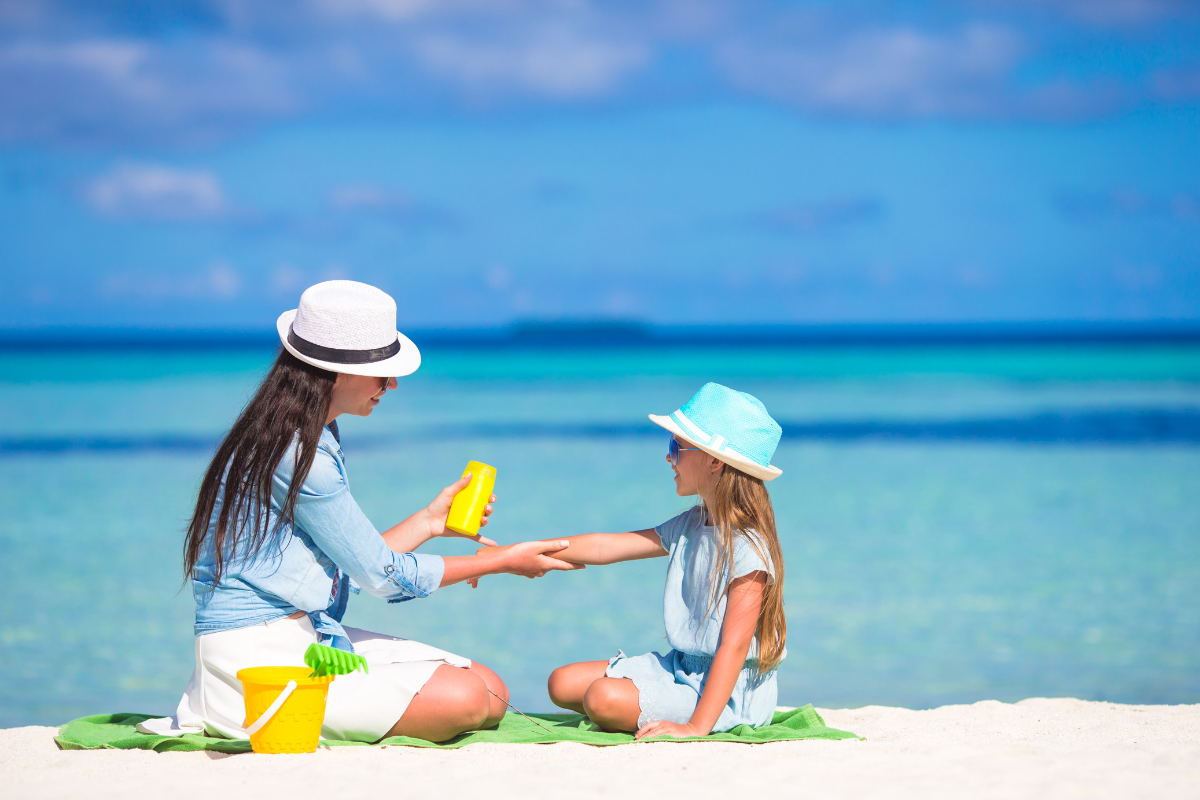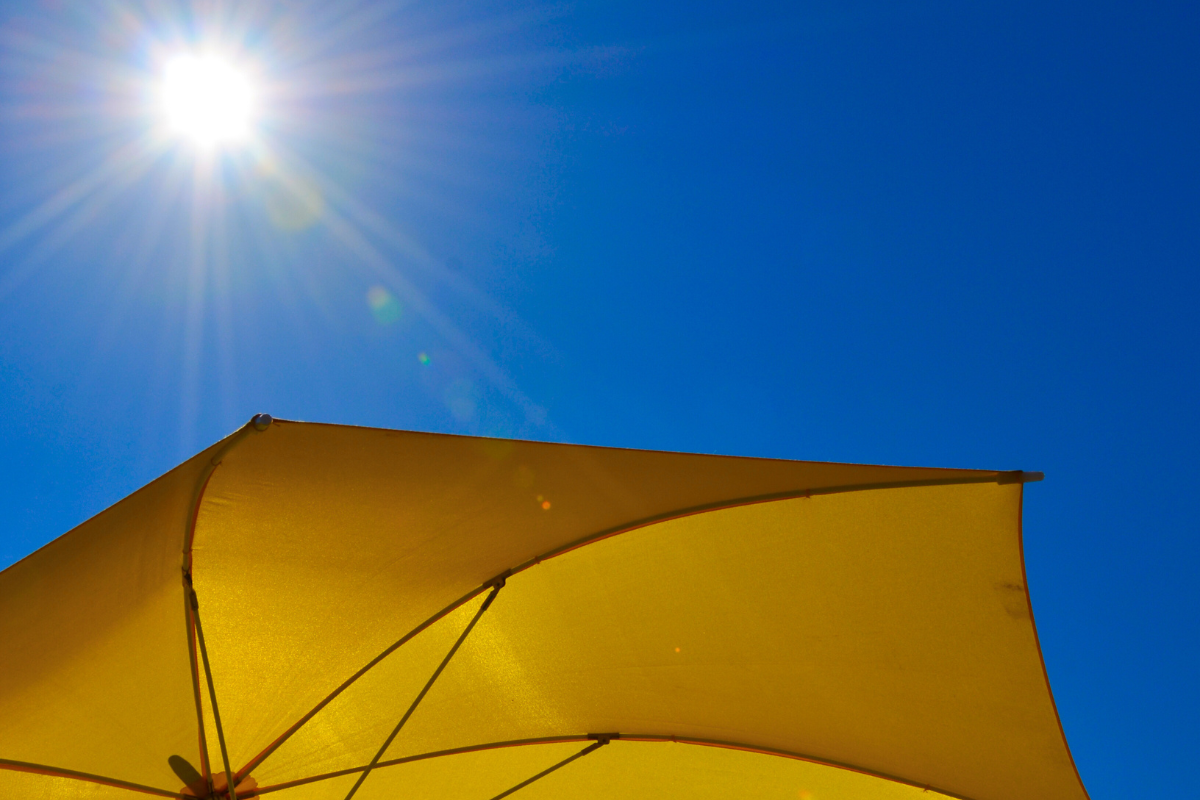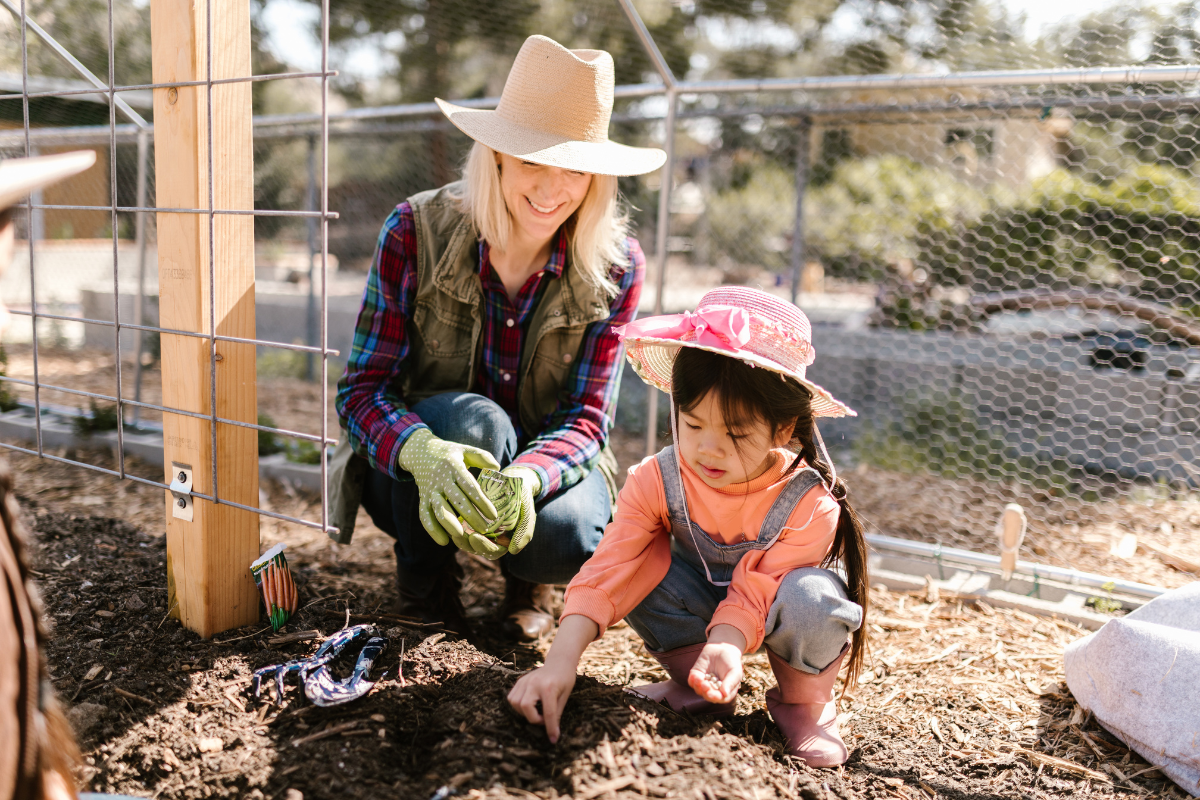For Australians, a love of the outdoors and active lifestyles makes time spent in the sun part of our everyday lives. However, the harsh reality is that this lifestyle can render us at greater risk of developing skin cancer.

Australia has the highest rate of melanoma and non-melanoma skin cancer in the world, with 2 out of 3 Australians diagnosed with skin cancer in their lifetime (1). In some Australian states, sun damage can occur after just ten unprotected minutes in the sun. Many Australians face this risk year-round, with even the cooler months through winter offering little to no protection from damaging levels of ultraviolet (UV) radiation (2).
Overexposure to UV is the strongest predictor of developing skin cancer (3). Emitted by the sun, UV radiation in large quantities harms human skin (4). Varying by location, the amount of UV radiation reaching Earth can differ considerably (5). Unfortunately, UV radiation levels are often in the high and extreme range in Australia (6). Importantly, we now know the effects of UV radiation are cumulative, with lifetime overexposure responsible for 95-98% of all skin cancer diagnoses (3). Acknowledging and taking the time to hone a practice to mitigate these risks should be at the forefront of all Australians who love the outdoors.
Outdoor enthusiasts have some of the highest levels of UV exposure. The prevailing evidence suggests that those who regularly engage in outdoor activities experience substantially higher UV radiation exposure for extended periods, increasing their risk of developing skin cancer (7, 8). Therefore, practising all avenues for sun protection is vital when spending time outdoors. Positively, iconic sun safety awareness campaigns like "Slip, Slop, Slap, Seek, Slide" have offered Australians a practical blueprint to inform our sun safety practice.
“Slipping on a shirt, slopping on sunscreen, slapping on a hat, seeking shade, and sliding on sunglasses is an easy recipe all Australians can follow to ensure they are being sun safe (9).”
However, despite this blueprint, improper sun protection practice is still prevalent (10). But improving sun safety can be easier than expected and achieved by making only minor changes to your current routine. So where do you start?
1. Use sunscreen correctly
Sunscreen is a critical protection against UV radiation and sunburn. A good sunscreen with a high protective factor (>30+) can offer considerable protection against harmful UV. For example, sunscreen with a sun protective factor (SPF) of 50+ provides 50 times more protection than bare skin (11). However, improper use of sunscreen is widespread (12). Too little sunscreen is often applied, notably reducing its efficacy (13). An easy rule of thumb is a teaspoon of sunscreen for the face and one each for the arms, with two teaspoons each for the torso and legs (14). It is theorised that the universal proper use of sunscreen could prevent 34% of melanoma diagnoses by 2031 (15). Therefore, practising appropriate habitual sunscreen use and reapplication is vital. Sunscreen should be reapplied every 2 hours or immediately after swimming, water-based activities, towel drying or if heavily sweating. Knowing when to reapply can be assured by using UV stickers or wristbands, which can be found easily online. These change colour when it's time to reapply sunscreen and are a compelling reminder to help avoid burning (16). Another option could be to use the free SunSmart Global UV app to set sunscreen reminders so you don't forget.
2. Wear a hat
Hat use is another vital component to practising adequate sun safety. Areas of consistently exposed skin, like the face, ears, and nose, have a greater incidence of skin cancer diagnosis compared with more covered areas (17). Swapping out a cap for a broad-brimmed, bucket or legionnaire style hat is an easy method to drastically reduce the level of UV exposure experienced as these protect the face, neck, and eyes better than caps or visors (18).
3. Wear sunglasses
Eye protection is a frequently overlooked facet of sun protection that can notably improve your sun safety practice. The eyes and eyelids are common areas for skin cancer to emerge (19). Good quality sunglasses which comply with Australian standards for UV protection and are graded in category 3 or greater offer 95% protection from UV radiation (20).
Tip: Look for sunglasses that are close-fitting, wrap around the eyes, and don't let light in around the frames.
4. Cover up
Sun protection also includes making smart choices about clothing. Even on cloudy days, wearing clothing with minimal skin coverage can markedly increase exposure to UV (21, 22). Sun-protective apparel, like those manufactured to the Australian and New Zealand clothing standards, have high ultraviolet protection factor (UPF). These clothes are easily found online and are safer than singlets or short-sleeved walking shirts. These garments offer a physical barrier between the skin and UV and are proven to protect against developing skin cancer (23, 24).
Tip: For clothes without a UPF rating, look for closely woven fabric as the tighter the weave, the better protection from UV radiation.
5. Time your outings and seek shade
Another important consideration is being cognisant of the time of day when UV is at its peak. Getting outdoors in the early morning or late afternoon when UV levels are lower can effectively reduce the risk of overexposure to UV. That said, when this is impractical, practicing sun safe behaviours and downloading the free SunSmart Global UV app, which provides quick and reliable information regarding the UV range, can help you stay informed about UV risks (25). Likewise, walking or engaging in outdoor activities in shady areas can offer considerable protection. Shade can protect against 75% of UV radiation and drastically lower the risk of UV damage, including sunburn, when coupled with other sun-protective behaviours (26, 27).
6. Make sun safe practice part of your everyday
Lastly, if you walk or exercise in a group, consider how you can address sun safety collectively. Social normalisation of healthy choices is a driving force for behaviour change (28, 29, 30). Making sun safe practice a regular part of your group's daily exercise routine can be a powerful motivator and an easy reminder of the importance of sun safety for yourself and others.
Making small improvements to your sun safety practice can significantly decrease your levels of UV exposure. Make good sun safety practice part of your everyday now so you can enjoy being active outdoors and protect yourself against skin cancer.
To find out more about how to be sun safe, visit:

Queensland Health (health.qld.gov.au)
Sun safety in outdoor settings

Cancer Council QLD (cancerqld.org.au)
Sun protection

Cancer Council SA (cancersa.org.au)
Be SunSmart
About the Author
John Ferguson is a Health Promotion Officer in the Central Queensland Public Health Unit focusing on the prevention and early detection of skin cancer. John holds a Master in Public Health with a major in Health Promotion from the University of Queensland. He is working alongside his colleagues from the Central Queensland Public Health Unit in collaboration with the Prevention Strategy Branch of Queensland Health as they initiate a skin cancer prevention project to increase advocacy for, awareness of and access to skin cancer prevention strategies and early detection services in regional Queensland.

References:
1. Australian Institute of Health and Welfare (AIHW). Skin Cancer in Australia Canberra 2016.
2. Gies P. Capital city maximum UV levels by month. . Melbourne Australian Radiation Protection and Nuclear Safety Agency; 2013.
3. Arnold M, de Vries E, Whiteman DC, Jemal A, Bray F, Parkin DM, et al. Global burden of cutaneous melanoma attributable to ultraviolet radiation in 2012. Int J Cancer. 2018;143(6):1305-14.
4. D'Orazio J, Jarrett S, Amaro-Ortiz A, Scott T. UV radiation and the skin. Int J Mol Sci. 2013;14(6):12222-48.
5. Nunez M, Forgan B, Roy C. Estimating ultraviolet radiation at the earth's surface. International Journal of Biometeorology. 1994;38(1):5-17.
6. Gies P, Roy C, Javorniczky J, Henderson S, Lemus-Deschamps L, Driscoll C. Global Solar UV Index: Australian measurements, forecasts and comparison with the UK. Photochem Photobiol. 2004;79(1):32-9.
7. Armstrong BK, Kricker A, English DR. Sun exposure and skin cancer. Australas J Dermatol. 1997;38 Suppl 1:S1-6.
8. Snyder A, Valdebran M, Terrero D, Amber KT, Kelly KM. Solar Ultraviolet Exposure in Individuals Who Perform Outdoor Sport Activities. Sports Med Open. 2020;6(1):42.
9. Tabbakh T, Volkov A, Wakefield M, Dobbinson S. Implementation of the SunSmart program and population sun protection behaviour in Melbourne, Australia: Results from cross-sectional summer surveys from 1987 to 2017. PLOS Medicine. 2019;16(10):e1002932.
10. Haynes A, Nathan A, Maitland C, Dixon H, Nicholson A, Wakefield M, et al. Prevalence and Correlates of Observed Sun Protection Behaviors Across Different Public Outdoor Settings in Melbourne, Australia. Health Education & Behavior. 2022;49(3):405-14.
11. Dermatologists ACo. Sun Protection & Sunscreens 2019 [Available from: https://www.dermcoll.edu.au/atoz/sun-protection-sunscreens
12. Whiteman DC, Neale RE, Aitken J, Gordon L, Green AC, Janda M, et al. When to apply sunscreen: a consensus statement for Australia and New Zealand. Aust N Z J Public Health. 2019;43(2):171-5.
13. Petersen B, Wulf HC. Application of sunscreen--theory and reality. Photodermatol Photoimmunol Photomed. 2014;30(2-3):96-101.
14. Isedeh P, Osterwalder U, Lim HW. Teaspoon rule revisited: proper amount of sunscreen application. Photodermatology, Photoimmunology & Photomedicine. 2013;1(29):55-6.
15. Olsen CA-O, Wilson LF, Green AC, Biswas N, Loyalka J, Whiteman DC. How many melanomas might be prevented if more people applied sunscreen regularly? (1365-2133 (Electronic)).
16. Horsham C, Ford H, Hacker E. Promoting sunscreen use in adolescents playing outdoor sports using UV detection stickers. Prev Med Rep. 2020;19:101166.
17. Subramaniam P, Olsen CM, Thompson BS, Whiteman DC, Neale RE, Sun QS, et al. Anatomical Distributions of Basal Cell Carcinoma and Squamous Cell Carcinoma in a Population-Based Study in Queensland, Australia. JAMA Dermatol. 2017;153(2):175-82.
18. Gies P, Javorniczky J, Roy C, Henderson S. Measurements of the UVR protection provided by hats used at school. Photochem Photobiol. 2006;82(3):750-4.
19. Krutmann J, Béhar-Cohen F, Baillet G, de Ayguavives T, Ortega Garcia P, Peña-García P, et al. Towards standardization of UV eye protection: what can be learned from photodermatology? Photodermatol Photoimmunol Photomed. 2014;30(2-3):128-36.
20. Australian Standard Sunglasses and Fashion Spectacles. . Sydney Standards Australia 2003
21. Lemus-Deschamps L, Rikus L, Grainger S, Gies P, Sisson J, Li Z. UV Index and UV dose distributions for Australia (1997-2001). Australian Meteorological Magazine. 2004;53(4):239.
22. Turner D, Harrison SL, Bates N. Sun-Protective Behaviors of Student Spectators at Inter-school Swimming Carnivals in a Tropical Region Experiencing High Ambient Solar Ultraviolet Radiation. Front Public Health. 2016;4:168.
23. Harrison S, Buettner P, MacLennan R, Woosnam J, Hutton L, Nowak M. Sun-safe clothing helps to prevent the development of pigmented moles–results of a randomised control trial in young Australian children. Ann ACTM. 2010;11(2):49-50.
24. Harrison SL, Buettner PG, MacLennan R. The North Queensland “Sun-Safe Clothing” study: design and baseline results of a randomized trial to determine the effectiveness of sun-protective clothing in preventing melanocytic nevi. American journal of epidemiology. 2005;161(6):536-45.
25. Nicholson A, Murphy M, Walker H, Tinker R, Dobbinson S. Not part of my routine: a qualitative study of use and understanding of UV forecast information and the SunSmart app. BMC Public Health. 2019;19(1):1127.
26. King E, Thompson S, Groskops N. Integrating shade provision into the healthy built environment agenda: the approach taken in NSW, Australia. Public Health Research & Practice.
27. Parsons PG, Neale R, Wolski P, Green A. The shady side of solar protection. Med J Aust. 1998;168(7):327-30.
28. Ball K, Jeffery RW, Abbott G, McNaughton SA, Crawford D. Is healthy behavior contagious: associations of social norms with physical activity and healthy eating. International Journal of Behavioral Nutrition and Physical Activity. 2010;7(1):86.
29. White KM, Starfelt LC, Young RM, Hawkes AL, Leske S, Hamilton K. Predicting Australian adults' sun-safe behaviour: examining the role of personal and social norms. Br J Health Psychol. 2015;20(2):396-412.
30. Ajzen I. The theory of planned behavior. Organizational behavior and human decision processes. 1991;50(2):179-211.